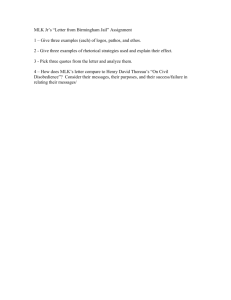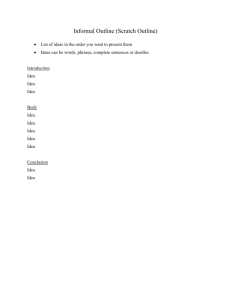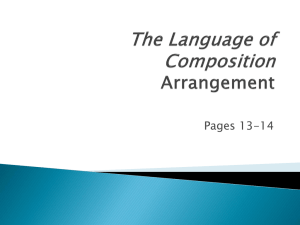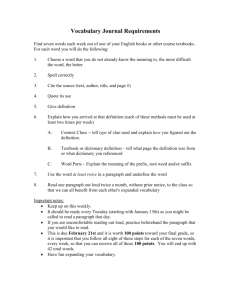File
advertisement
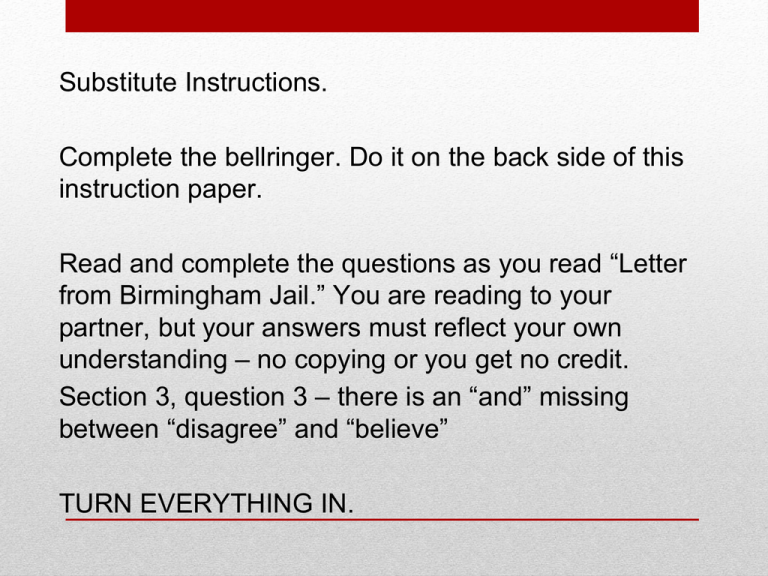
Substitute Instructions. Complete the bellringer. Do it on the back side of this instruction paper. Read and complete the questions as you read “Letter from Birmingham Jail.” You are reading to your partner, but your answers must reflect your own understanding – no copying or you get no credit. Section 3, question 3 – there is an “and” missing between “disagree” and “believe” TURN EVERYTHING IN. •Bellringer: Feb. 24 Write this in your notebook. Currently, the RESPECT campaign is occurring. It used to be called “Spread the Word to End the Word.” It calls for tolerance and acceptance of those who are developmentally different. What rhetorical device does this campaign seem to rely on the most? What’s your evidence? If you aren’t sure about the campaign, listen to the announcements or talk to your partner. •Use reading guide to help analyze King’s approach. •Evaluate his use of ethos, logos, and pathos to see if his piece is more persuasive or argumentative. •Prepare to answer the question: How does MLK employ ethos, logos, and pathos in “A Letter From Birmingham Jail” to construct his message? • Here’s another LONGER video which incorporates both “A Call for Unity” and “Letter from Birmingham Jail” if you need some help at home: Univerity of Texas at Austin's video Reading Goals Getting Started. Window partner: read paragraph 1 out loud. Answer the questions in your notes. • Window partner: Why is he writing this response? • Door partner: How does he specifically address the authors of “A Call for Unity”? Going on… paragraph 2 Door partner: Read paragraph 2 out loud. Answer the questions in your notes Door partner: write a 10 word summary of this paragraph. Window partner: Which vocabulary term matches most closely with this type of paragraph? (look on the bulletin board to your right – any of those words are fair game). Why is it this term? Moving Forward: Window partner read paragraph 3 out loud: Answer the questions in your notes Window partner: Why does he include all of these biblical references? Door partner: Is this paragraph relying on ethos, logos, and/or pathos? WHY? Next! Paragraph 4: Door partner read out loud. Answer the questions in your notes Door partner: What in “A Call for Unity” is MLK specifically rebutting? Window partner: Why isn’t he an “outsider”? Oh snap! Paragraph 5 Window partner read out loud. Answer the questions in your notes Window partner: what is MLK’s criticism? Door partner: Describe MLK’s tone here. Together: does this paragraph rely on ethos, logos, and/or pathos? Why? Paragraphs 6-8 Door partner read out loud. Answer the questions in your notes Door partner: What is the purpose for these paragraphs? Window partner: What does King outline here? Together: Do these paragraphs rely on ethos, logos, and/or pathos? Why? Paragraphs 9-10 Window partner read out loud. Answer the questions in your notes Window partner: 10 word summary of paragraph 8 Door partner: 10 word summary of paragraph 9 Together: How does he defend his choice to protest? Together: Do these paragraphs rely on ethos, logos, and/or pathos? Why? Paragraph 11 Door partner read out loud. Answer the questions in your notes Door partner: 10 word summary of paragraph 10 Window partner: Which vocabulary term matches most closely with this type of paragraph? (look on the bulletin board to your right – any of those words are fair game). Why is it this term? Paragraph 12-13 Window partner read out loud. Answer the questions in your notes Window partner:10 word summary of paragraph 11 Door partner: Why is this a solid example of using Pathos? Together: In the first 11 paragraphs, King focuses on the WHY and WHY NOW behind his current plan. Summarize his WHY and WHY NOW. Section 2 – 5 of “Letter from Birmingham” Continue reading, switching paragraphs. Complete the reading guide questions: IN YOUR NOTES – don’t write on my class copy of the questions. When we are finished, we will be having a class discussion of King’s letter. You will be prepared by reading the speech and answering the study guide questions. Discussion: • How does King create his ethos for his intended audience? Why can he not rely on his credentials and leadership roles? • How does King create a logical argument throughout his response? • How does King use pathos effectively? (not too much, not too little) Answer the lesson question if you finish reading everything and completing the questions. How does MLK employ ethos, logos, and pathos in “A Letter From Birmingham Jail” to construct his message?
